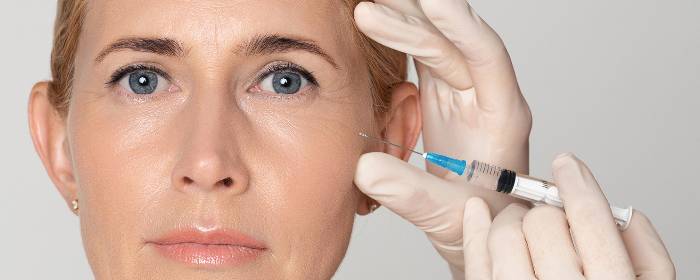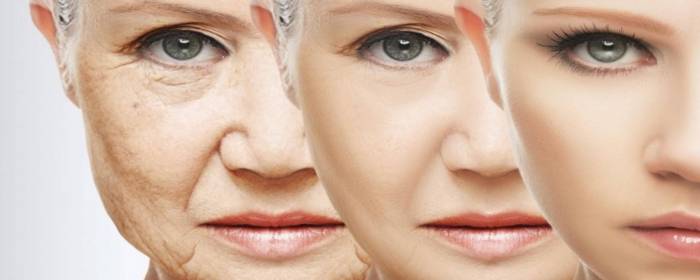
by admin | Sep 2, 2019 | Aesthetics, Stem Cell Therapy
No matter how young we may feel, our aging skin often gives our age away. As we age, we lose important proteins in the skin like collagen and elastin. We also lose a thin layer of fat that lies just below the skin. Without this fat and protein, the skin sags and loses its elasticity (“bounce back”) appearing thin and wrinkly.
One of the main skin rejuvenation techniques is to inject fat into aging skin. In its most basic form, a bit of fat is removed from the patient via liposuction and injected into an area of aging skin. These transplanted fat cells give the skin a plumper appearance and seem to turn back the clock on skin aging. However, mature fat cells do not last forever, and many people need to have repeated skin rejuvenation procedures to maintain the effect.
More recently, however, physicians have realized that they achieve better results when they include stem cells in their fat grafts. The mature fat cells provide a beauty benefit immediately, while stem cells help maintain the effect longer. Some physicians have taken the procedure so far as to only inject stem cells and remove mature fat cells completely. While this approach seems reasonable, is unclear whether the stem cell-only approach is actually superior.
While the benefit of fat grafts that include stem cells is widely known, it is unclear how the process works. By understanding the process, researchers hope to learn what provides the strongest antiaging effect. To help them better understand the skin rejuvenation process of fat-derived stem cells, researchers performed liposuction on several patients and then reinjected fat cells and stem cells into areas of aging skin. Three months later, the researchers took samples of the skin to see what effect the combination of fat cells and stem cells had on the skin structure.
While the specific results are quite complex, researchers found that a fat graft that included adipose-derived stem cells improved the elasticity of the skin by creating what is known as an “oxytalan elastic network.” These fibers helped to smooth out the skin and allowed it to retain more moisture than it did before skin rejuvenation treatment.
Perhaps most importantly for patients, the skin rejuvenation procedure left patients with fuller, younger-looking skin.
The researchers concluded that the most beneficial skin rejuvenation approach is to inject a combination of fat cells and stem cells derived from fatty tissue. The benefits were the same as those obtained by injecting stem cells alone. The researchers argue that the combination approach provides a good clinical benefit with the added benefits of being easier to perform, cheaper, and less prone to complications.
Reference: Charles-de-Sá, L. et al. (2015). Antiaging treatment of the facial skin by fat graft and adipose-derived stem cells. Plastic and Reconstructive Surgery. 2015 Apr;135(4):999-1009.

by admin | Jul 25, 2019 | Age Management, Mesenchymal Stem Cells, Stem Cell Research
Aging skin goes through a number of predictable changes. Skin loses collagen and other proteins as it ages, making the skin appear dull, saggy, discolored, and wrinkly. Many of these changes are due to the sun, as it bombards the skin with harmful ultraviolet (UV) radiation. When the skin is exposed to the sun’s UV radiation, it produces reactive oxygen species and leads to oxidative stress. The result is of these oxygen radicals is thickened, damaged, photo-aged skin. Unfortunately, the cells that could help replenish and rejuvenate the skin—epidermal progenitor cells—may also be damaged by UV radiation. Indeed, as we age, we produce fewer and fewer of these helpful cells. Thus, the skin is left defenseless.
Researchers are looking for ways to fight back against the ravaging effects of age and sun damage on human skin. Some have reasoned that if the skin lacks epidermal progenitor cells during aging, why not try to protect or restore those cells? Consequently, some scientists have studied the effects of injecting stem cells directly into the skin (with promising results). However, many patients would like to have the same skin rejuvenation effect without painful injections. Scientists are learning that the beneficial effects of stem cells come mostly from the things that they secrete rather than the stem cells themselves. This means that doctors could potentially take the fluid that a stem cell secretes and use that liquid as a treatment, rather than injecting whole stem cells into a patient’s skin. Indeed, this is the approach that researchers recently pursued and published.
Researchers began their research by collecting epidermal progenitor cells taken from mesenchymal stem cells. These epidermal progenitor cells are the stem cells that give rise to skin. Epidermal progenitor cells also produce substances that help support natural, youthful skin growth and development. The researchers allowed these epidermal progenitor cells to produce and release substances into the surrounding solution. They then collected that solution and used it in subsequent experiments.
In the first set of experiments, researchers showed that the cell-free fluid derived from stem cells could protect skin cells from oxidative stress caused by hydrogen peroxide. Indeed, something (or things) released by the stem cells prevented skin cells from undergoing the types of changes they would endure during sun damage. In fact, the treatment apparently caused the skin to increase its own natural defenses by producing more antioxidant enzymes and increasing the creation of new collagen.
Encouraged by these results, the researchers then conducted a clinical study of 25 people between the ages of 29 and 69. They took the same cell-free fluid derived from stem cells and applied it topically to the skin of volunteers twice a day for four weeks. The treatment significantly reduced skin depressions and wrinkles. Treatment also noticeably improved the texture of the skin.
Given the apparent safety and efficacy of this cell-free treatment, researchers are likely to continue to test these treatments in larger clinical trials. The results are exciting because they offer the possibility of a topical stem cell treatment without directly injecting stem cells themselves. Indeed, patients may someday be able to use cell-free stem cell skin rejuvenation treatments at home.
Reference: Sohn, SJ. et al. (2018). Anti-aging Properties of Conditioned Media of Epidermal Progenitor Cells Derived from Mesenchymal Stem Cells. Dermatology and Therapy. 2018 Jun;8(2):229-244.

by admin | Nov 26, 2018 | Adipose, Aesthetics, Stem Cell Therapy
Although all living organisms experience aging, scientists have relatively little understanding of why aging occurs. The leading theories on aging suggest that living creatures sustain damage to their DNA through exposure to ultraviolet light, toxins, or even the day-to-day stresses of using oxygen for our cellular metabolism. Whatever the cause, this DNA damage causes cells to 1) repair themselves, 2) die, or 3) enter a middle state called senescence where they remain alive, but simply stop participating in active living. If cells successfully repair themselves, they don’t perceptibly age. If cells enter senescence or die, the body shows signs of aging.
The bottom line: If we can help cells repair themselves, and replace dying and senescent cells, we can slow or even reverse aging. All of this may be possible through the careful use of stem cells.
As we age, stem cells lose the ability to renew themselves, to become other cells (differentiate) and to replace aged cells. Older stem cells secrete less and less of the substances that help the cells around them stay young and healthy. Not only do our regular cells age, but so do our stem cells. This is perhaps the strongest point for using stem cells to reverse the visible signs of aging.
Adipose-derived stem cells are one of the most promising sources of stem cells for anti-aging and regenerative medicine. They are easy to harvest by liposuction to remove stem cells along with fat cells. In addition, adipose-derived stem cells have the potential to become all cell types in the skin; namely fat cells, skin cells, muscle cells, and fibroblasts, and others. Even if the stem cells do not become other cells, they strongly secrete cytokines and other substances that help renew and replenish the cells around them.
While additional research is required, adipose-derived mesenchymal stem cells are currently being tested in clinical trials to treat a number of age-related conditions. Indeed, clinicians are currently using the stem cells to perform a number of aesthetic procedures such as breast or buttock augmentation, hand rejuvenation, as facial dermal fillers, and to promote and restore hair growth. As we learn more about how to use the power of stem cells in aesthetic procedures, we will be able to better address the visible signs of aging in the face and body.




 St. Petersburg, Florida
St. Petersburg, Florida
